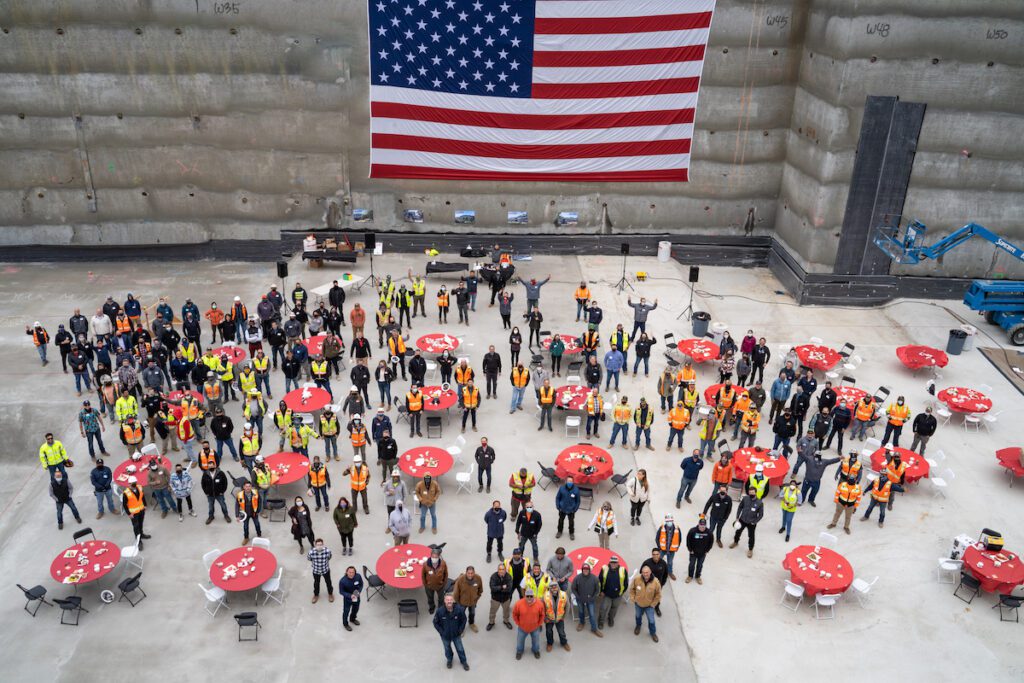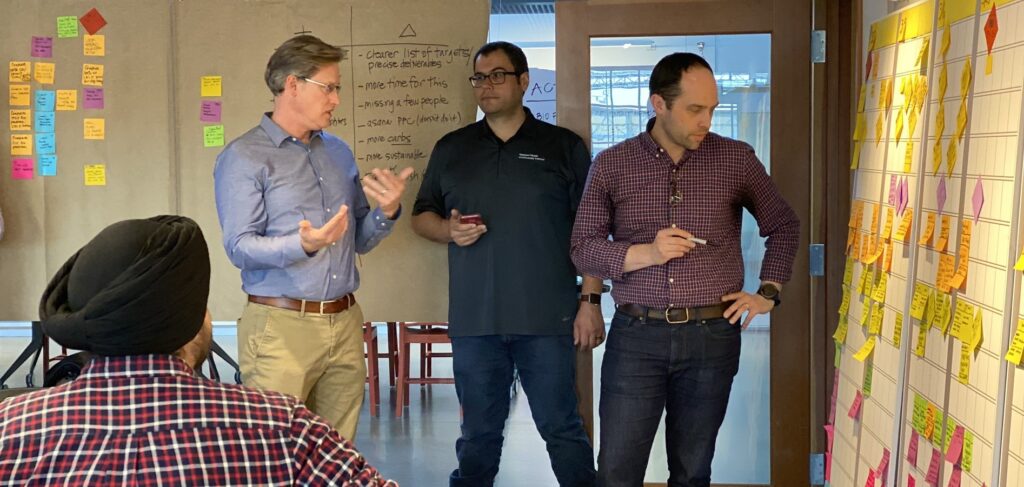Hyper-collaboration helps McCarthy-led team solve roadblocks on Google’s Youtube Campus Expansion

Table of Contents
- Challenge: Build a high-profile design-build/TVD corporate campus that meets Google’s exacting standards for project execution and outcomes, with two giant complications: soon-expiring entitlements and a global pandemic
- Solution: Create a “one team” culture united around a strong mission, and leverage the Join collaboration platform to drive the project ever-forward
- “One Team” Culture
- Empowered TVD Teams, Clear TVD Processes
- Outstanding User + Owner Experience
- Join in Construction

“The visibility that Join brings to the design team really helped move the needle on this project because they could actually have some trust in our numbers.”
“The visibility that Join brings to the design team really helped move the needle on this project because they could actually have some trust in our numbers.”

Sr. Vice President & Business Unit Leader, McCarthy
Challenge: Build a high-profile corporate campus that meets Google’s exacting standards for project execution and outcomes, with two giant complications: soon-expiring entitlements and a global pandemic
There are 1,000 ways to fail on a TVD project: Lack of trust. Inappropriate tools. Lack of effective team interaction. But St. Louis-based McCarthy Building Companies–ranked #17 on the ENR Top 100 Design-Build firms–has proven experience mitigating those challenges, which helped the company in 2019 win the contract for the technically complex Design-Build/TVD YouTube Campus Expansion project for Google, one of the largest, most demanding tech companies in the world.
On the face of it, the project was simple enough for a firm like McCarthy, with its strong culture of innovation and vast portfolio of Design-Build/TVD projects. McCarthy’s design partner, San-Francisco-based EHDD, had equally relevant experience with the project type and delivery method. This project, however, had two high-stakes complications:
1) The complex was designed two decades prior, which meant the team had to meet certain milestones–fast–before the entitlements expired; and
2) in the middle of project planning, a global pandemic hit and the team had to go fully remote.
Solution: Create a “one team” culture united around a strong mission, and leverage the Join collaboration platform to drive the project ever-forward
“One Team” Culture
A North Star and a Team Charter: Google has a clear North Star for its corporate office environments–an exceptional end-user experience. As such, it has established its own company-centric design and construction processes that involve the input of multiple internal stakeholder groups throughout the project.
“It was our first project with Google. We knew we needed to do this right. So, we started thinking about what collaborative delivery looked like and what that meant to them.”
Derek Fitzgerald, Sr. Vice President and Business Unit Leader, McCarthy
Fitzgerald says the team studied the Google’s own research on high-performing teams and then sat down with Google, the design team, and consultants and talked about what success would look like for the project.
Out of that exercise, the team developed a Team Charter around delivering a highly sustainable world-class facility that people would be excited to work in.

Identifying Collaborative Team Behaviors. With the Team Charter solidified, the team then began to identify how it wanted to operate. “In the background,” Fitzgerald continues, “we were thinking about Join; how it would support this high-performing team and help us deliver the project YouTube wanted.”
Then the unthinkable happened: COVID 19 shut everything down in March 2020. While the world stopped, the clock was still ticking on the project’s entitlements, set to expire by the end of 2020. To avoid the entitlements expiring (and triggering new environmental impact reports, which could take 2+ years), the team had to meet an extraordinary milestone: be substantially under construction–or, at the bottom of the 70-ft. excavation for the underground parking structure and starting to come back up–before the end of the year.
Complicating the excavation plan was the fact that San Francisco’s main water lines run directly beneath the project. Any disruption to them would be disastrous. That meant the team had to quickly figure out how to collaborate entirely virtually, while making time-sensitive decisions on the excavation plan.
No Big Room? No Problem. “So, we’re in a really peculiar scenario,” Fitzgerald adds. “We’re gearing up to move into a collaborative Big Room space. Now, we all have to go to our homes and do everything from different places.” He says that while the team had always targeted Join for this concept, the lack of a Big Room “really accelerated our vision of how important Join would be because it is a “single source of truth,” where the hundreds of people on the project could track key decisions and costs, andd simplify communication.
Join was quickly deployed and the project estimates were entered into the system. The team also began using Join to track key decisions around the uber-important excavation.

Empowered TVD Teams, Clear TVD Processes
Company-Wide Buy-In: The decision to use Join, says McCarthy Preconstruction Director Dan Crosby, was supported by the C-level and championed by previous McCarthy Join users, including himself, Vice President of Design Integration Stef Becker, Preconstruction Director Denzil D’Sa, and Director of Estimating Kelly Ortiz. They stressed the importance of using the platform and their own successful experience with it, Crosby says.
McCarthy worked with Join to train its current users and held weekly onboarding sessions for new people to the project, from the architects all the way down to the person drafting the CAD files for the landscape design.
Functional Team Organization: McCarthy organized the project into “Functional Teams,” or by major scope: site, envelope, structure, MEP, interiors, etc. Each team had participants from McCarthy, EHDD, the design consultants, key Design-Build trade partners, and Google, as well as subject matter experts and representatives of the Google’s stakeholder groups.
The Functional Teams each had their own budgets that they needed to design to. If a Functional Team got stuck on a decision, or if a decision exceeded $1 million, it was bubbled up to Air Traffic Control and the Leadership Team. “That’s how we started to funnel up really big important decisions, but still leave the Functional Teams with enough autonomy to drive toward targets that we set. And we used the Join tool to do that,” says Fitzgerald.
“We even did mock exhibits (in Google chat rooms because we were remote) of how to do a successful Join item in a Functional Group, says McCarthy Vice President/Project Executive Mike Gilpin. That involved demonstrating how a Functional Team might have an idea, price it, refine it, and present it to Google in the weekly TVD cadence for incorporation.
Functional Team Decisions: McCarthy used Join to set the target value. The company had an initial conceptual estimate and the team worked to align it with the owner’s budget. However, once it got what it calls a “true target,” McCarthy’s Join users would input that information into the latest estimate and break that target value down by scope. Then those teams would use the platform to track cost savings ideas or design changes.


“No one likes to design twice,” says EHDD Architect/Senior Associate Ken Powelson, AIA. “Let’s design once to a target budget and make sure we get to a great design result on budget the first time.”
EHDD Partner & COO Brad Jacobson, FAIA, adds that “it helps to have a target budget that incorporates client values and priorities, that actually sets aside money for feature elements, and that looks for money in unexpected places.”
An example of how that worked on the project? “We needed to find several million dollars of cost savings in this project,” Powelson says. “Using Join, we were able to identify big ticket items that nobody cared about except that it worked; in our case, the underground egress tunnel at the parking garage. We spent three weeks of concerted design time working out an alternative egress plan that worked not only for code but for security, and saved a huge chunk of money. That allowed us to not have to nickel and dime the project in VE, which takes time but also affects the design in more noticeable ways.”
Other ways in which the Functional Teams vetted out cost saving ideas in Join include the reduction of acoustical ceiling tiles used in the office buildings. Says D’Sa, Functional Team lead for the interiors: “There was 75% coverage of the ceilings, and we were, like, well that seems excessive. Ultimately, we were able to work with the acoustical consultant to do an acoustic model that incorporated 50% coverage of the ceilings. And they were able to provide the actual data on the expected acoustics that supported the new percentage.”

“And after all the work has been done, everything’s all there in one place, and it allows you to present a cohesive message.”

Preconstruction Director, McCarthy
“Where Join comes into the decision,” D’Sa says, “is that it forces you to go through a process of getting something tangible and quantifiable into Join; including options you can then price. The history of an item lives in Join within the item description and the comments feature. And it allows everyone to go back and regroup. And after all the work has been done, everything’s all there, and it just allows you to present a cohesive message.”
Outstanding User + Owner Experience

User Joy
How does a complex project like this work without Join? “Terribly,” says Fitzgerald, “which is why we love the tool so much. More often than not, we’re taking a Functional Team approach now on most of our projects. And we’re using Join on them vs. using a massive spreadsheet with multiple tabs and lacking visibility to the design team and the owner. I think the visibility that Join brings to the design team really helped move the needle on this project because they could actually have some trust in our numbers”
“With Join, everything is in one place,” adds D’Sa. “Everyone from the architect to the engineers and the cost consultant can see the estimate, the alternative solutions, and the costs associated with them. There is detail and backup in here, and it’s justifiable. There is just more transparency into the whole process of how we arrive at a number, and they get to be brought along through that journey.”

Owner Joy
McCarthy, an employee-owned company, has incorporated Join into its workflows, driven largely by the professionals who have successfully used it to drive better project outcomes. Owners are also sold on the power of the platform, says D’Sa, particularly Google, who was laser-focused on the end-user experience.
As D’Sa explains it, Google wants to redo their spaces every seven years to ensure they continually reflect user needs. To that end, Google has a “Day One and Day Two” approach. As an example, D’Sa references the acoustical tile decision. The 50% ceiling coverage decision represents Day One, which would be when the users moved into the buildings. But Google also wanted to understand the Day Two costs, or what it might cost if, after Day One, the users say they want stronger acoustics. “Google then has an understanding of that exposure and can keep it in their back pocket for Day Two improvements. We used Join to price out those options and give them those values for decision-making.”
“Join puts the joy back into OAC meetings…the owner could see how the decision moved the budget needle and how it helped trend the project in the direction they wanted to take it. They loved the visualization.”
Dan Crosby, Preconstruction Director, McCarthy
Join in Construction
Google liked Join so much they asked the team how it could be used beyond establishing the GMP. “So we also used it to track contingency, before Join had even introduced its contingency tracking system,” says Dan Crosby, Preconstruction Director. “It also became a change tracking tool.”
Adds Gilpin: “Once we got to the GMP, we said, ‘We all love this tool. How do we use it going forward?’ What we eventually landed on using Join to reflect most changes. If the change was going to be funded with owner money coming into the project, as opposed to within contingency allowance, then we would reflect that on the Join item showing new money coming in. That way the owner constantly understood the upper and lower bounds of all the pending changes to the job. It gave them a snapshot of what the range of the project could be. It was really helpful.”
The McCarthy/EHDD Design Build Entity delivered on its promise of building a world-class work environment for the Google’s valued employees. And it did so on schedule and below the target budget.
“When you see the pathway and you can see the roadmap and all the options with the little yellow bars above and below your target, you know what’s possible.”
Mike Gilpin, Vice President/Project Executive, McCarthy
“Join was the platform we used to get us there,” says Gilpin. “It’s incredibly gratifying to watch it happen every single week at the TVD meeting of people making decisions. Because when you see the pathway and you can see the roadmap and all the options with the little yellow bars above and below your target, you know what’s possible.”

